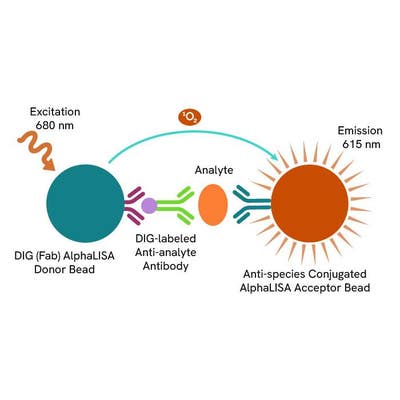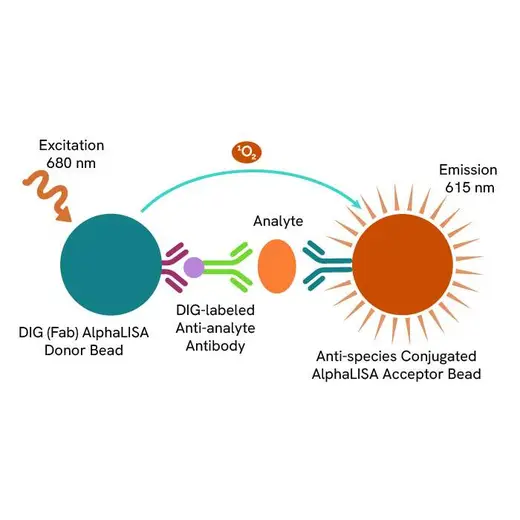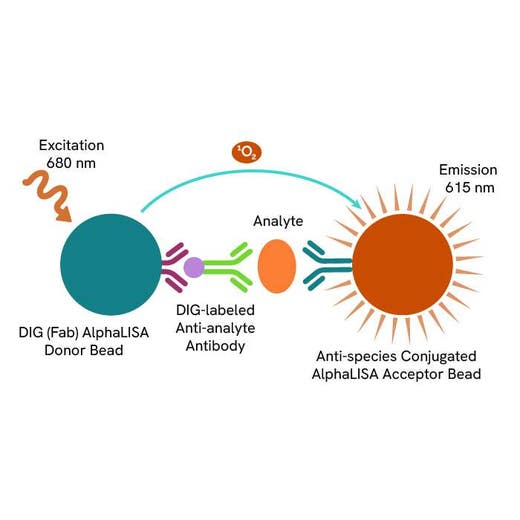
AlphaLISA Human IL-2 High Performance & Biotin Free Detection Kit, 100 Assay Points


AlphaLISA Human IL-2 High Performance & Biotin Free Detection Kit, 100 Assay Points






The AlphaLISA™ High Performance (HP) Biotin-Free Human IL-2 Detection Kit is designed for the quantitative determination of human IL-2 in serum, buffered solution, or cell culture medium using a homogeneous (no wash steps, no separation steps) assay.
This kit is the new and improved version of part number AL333,biotin-free interleukin-2 detection kit.
| Feature | Specification |
|---|---|
| Application | Protein Quantification |
| Dynamic Range | 0.70 - 300,000 pg/mL |
| Limit of Detection | 0.70 pg/mL |
| Limit of Quantification | 2.70 pg/mL |
| Sample Volume | 10 µL |
The AlphaLISA™ High Performance (HP) Biotin-Free Human IL-2 Detection Kit is designed for the quantitative determination of human IL-2 in serum, buffered solution, or cell culture medium using a homogeneous (no wash steps, no separation steps) assay.
This kit is the new and improved version of part number AL333,biotin-free interleukin-2 detection kit.



AlphaLISA Human IL-2 High Performance & Biotin Free Detection Kit, 100 Assay Points



AlphaLISA Human IL-2 High Performance & Biotin Free Detection Kit, 100 Assay Points



Product information
Overview
Interleukin 2 (IL-2), formerly known as T-cell growth factor (TCGF), is a 15 kDa immunoregulatory lymphokine produced by lectin- or antigen-activated T cells and capable of inducing the thymic expansion of recently activated antigen-specific T lymphocytes. However, since T-cell immunity can be elicited to various agents in the absence of IL-2 in vivo, it is currently thought that the main non-redundant activity of this cytokine is the induction of the suppressor function of CD4+CD25+ regulatory T cells (Treg) in peripheral lymph nodes to ensure suppression of autoreactive T cells that escape negative selection. Moreover, studies suggest that IL-2-mediated regulation of Treg cells is important in the prevention of type 1 diabetes and autoimmune disease.
Formats
- Our 100 assay point kit allows you to run 100 wells in 96-well format, using a 100 µL reaction volume (10 µL of sample).
- Our 500 assay point kit allows you to run 500 wells in 96-well or 384-well format, using a 50 µL reaction volume (5 µL of sample).
- Our 5,000 assay point kit allows you to run 5,000 wells in 96-well or 384-well format, using a 50 µL reaction volume (5 µL of sample).
Features
- No-wash steps, no separation steps
- ELISA alternative technology
- Sensitive detection
- Broad sample compatibility
- Small sample volume
- Results in less than 3 hours
- Half the time of an ELISA assay
AlphaLISA technology allows the detection of molecules of interest in a no-wash, highly sensitive, quantitative assay. In an AlphaLISA assay, a biotinylated anti-analyte antibody binds to the Streptavidin-coated Donor beads while another anti-analyte antibody is conjugated to AlphaLISA Acceptor beads. In the presence of the analyte, the beads come into close proximity. The excitation of the Donor beads causes the release of singlet oxygen molecules that triggers a cascade of energy transfer in the Acceptor beads, resulting in a sharp peak of light emission at 615 nm.
Specifications
| Application |
Protein Quantification
|
|---|---|
| Automation Compatible |
Yes
|
| Brand |
AlphaLISA
|
| Detection Modality |
Alpha
|
| Dynamic Range |
0.70 - 300,000 pg/mL
|
| Limit of Detection |
0.70 pg/mL
|
| Limit of Quantification |
2.70 pg/mL
|
| Product Group |
Kit
|
| Sample Volume |
10 µL
|
| Shipping Conditions |
Shipped in Blue Ice
|
| Target |
IL-2
|
| Target Class |
Cytokines
|
| Target Species |
Human
|
| Technology |
Alpha
|
| Therapeutic Area |
Autoimmunity
Immuno-oncology
Neuroscience
Oncology
|
| Unit Size |
100 Assay Points
|
Video gallery

AlphaLISA Human IL-2 High Performance & Biotin Free Detection Kit, 100 Assay Points

AlphaLISA Human IL-2 High Performance & Biotin Free Detection Kit, 100 Assay Points

Resources
Are you looking for resources, click on the resource type to explore further.
Cytokines play an essential role in inflammatory processes, leading to their involvement in viral and bacterial infections, as...


How can we help you?
We are here to answer your questions.






























